When we stepped out onto the roof, the wind whipped me sideways, and it took me a second to get my bearings. I was nine storeys above Times Square, staring at the back of its biggest LED sign, and it was thrilling.
Of course, standing on a dirty rooftop shouting over the cacophony of Midtown Manhattan is not thrilling in and of itself. I was with an engineer from D3 LED, one of the leading digital display manufacturers in the world, who was explaining to me how the sign worked. Gizmodo’s photo savant Michael Hession was wandering around, shutter snapping, and I was staring down into the guts of the 100-foot-wide LED display. As the engineer explained how the modular LED panels could be swapped out in seconds and the entire display switched with just a few key strokes, I straightened up.
“So you’re saying it’s just one big huge computer?” I asked.
He thought for a second and then nodded, “Pretty much.”
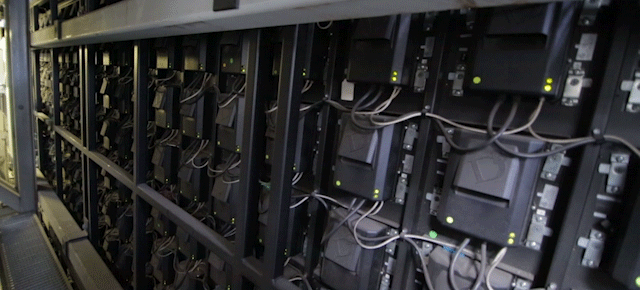
This is the back of the largest continuous surface LED display in Times Square. The blinking green lights mean that everything is working!
New York City’s Biggest Gadget
Times Square is one big, busy machine. Powered by American ingenuity and more than a few megawatts of electricity, these six square blocks stay bright 24 hours a day, seven days a week. You’ve seen Times Square in movies and on TV a million times. A lot of you have probably seen it in real life, teeming with chaos and glowing with capitalism. But how exactly does all that work? The shops and restaurants are one thing, but what exactly makes Times Square such a functional, perpetual spectacle?
That’s a complicated question. Obviously there are the workers themselves. Times Square supports some 385,000 jobs, a little over half of which are in that bright sliver of Midtown, while the other half are strewn across the country supporting Times Square operations from designing the content on the signs to keeping the power plants that power them on line. All together, they help generate about 11 per cent of New York City’s economic output, or about $US110 billion annually, according to the latest figures. These are the men and women who man the ticket booths, who sell the T-shirts, who clean the hotel rooms, and who keep everyone safe. And since about 350,000 pedestrians pass through Times Square on an average day — that number jumps to 460,000 on the busiest days — that’s no small task.
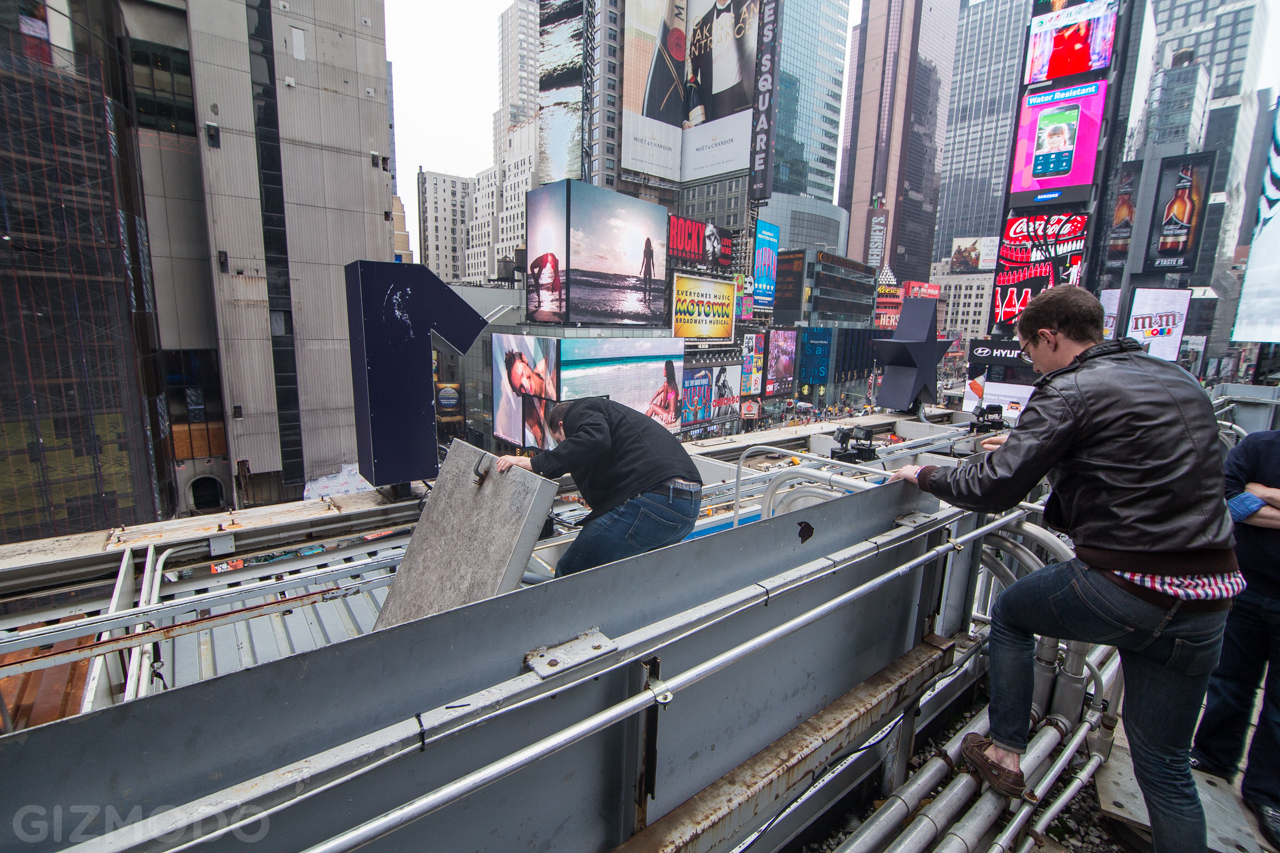
We actually got to climb inside the sign that sits on top of the Double Tree hotel. It was as precarious and scary as it looks.
But then there’s the technology. Times Square is home to countless billboards, many of which are now digital, that make up some of the most expensive advertising real estate in the world. These signs are so central to the area’s identity that there’s actually a zoning code that requires all buildings on that stretch of Broadway to have at least one illuminated sign of a certain size. And while the buildings themselves aren’t too different than those found throughout the rest of Manhattan, Times Square does have that big ball.
Put simply, Times Square works thanks to a productive marriage of labour and technology. And what better manifestation of these two things than those countless billboards that turn night into day in the middle of Manhattan? They bring in tourists. They drive up real estate prices. They fuel innovation in media and advertising in a manner unlike any other place on Earth. Put simply: Times Square works as long as those signs are shining.
It Wasn’t Always Like This
Times Square was still considered countryside when John Jacob Astor started buying up real estate in the first half of the 19th century. By the beginning of the 20th century, the area — then known as Longacre Square — had been considerably built up, having become home to The New York Times as well as a subway stop (in that order). On April 9, 1904, the paper announced the new moniker with a bold headline: “Times Square Is the Name of City’s New Centre.” Three years later, in 1907, Times owner Adoph S. Ochs lowered an illuminated ball down a pole on the roof of One Times Square in the last minute of the year, a tradition that endures today. It was, arguably, the first electrified advertisement in Times Square.
A few decades later, Times Square had become the center of New York’s sin city. The theatre district that had made the area an entertainment hub was eclipsed by the seedy strips of sex shops and adult cinemas. This, along with an ever-growing crime problem, is part of why the Times called the area around its former home “the ‘worst’ in town” by 1960. The slide into seediness continued through the 1970s and 1980s, eventually slowing with the election of Rudy Giuliani and an aggressive push to boost security and encourage tourists. That eventually meant those porn theatres had to close.
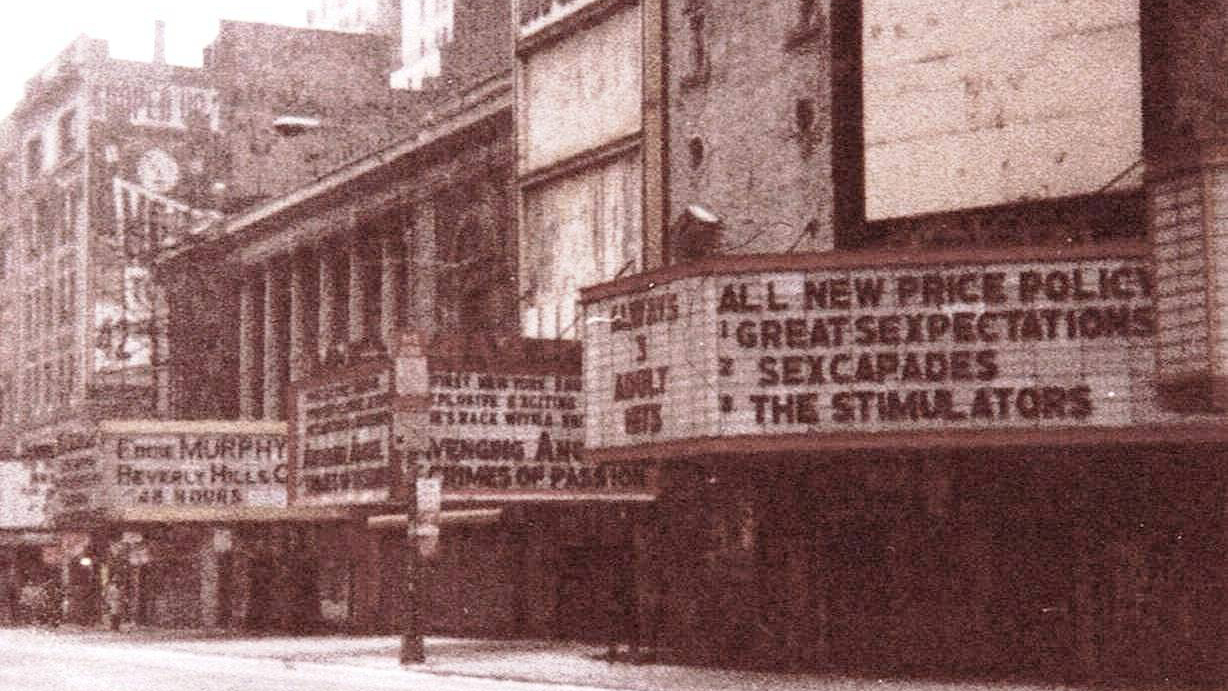
“Seedy” is almost too gentle a word to describe Times Square in the 1980s.
Times Square was properly “Disneyfied” by the mid-1990s. While it’s widely believed that aggressive urban planning caused the rebirth of Times Square, the former head of New York’s Urban Development Corporation says that’s not quite right. “The changes in Times Square occurred despite government, not because of it,” wrote William J. Stern a few years ago. “Times Square succeeded for reasons that had little to do with our building and condemnation schemes and everything to do with government policy that allowed the market to do its work, the way development occurs every day nationwide.”
What better beacon of progress than a bunch of blinking — and eventually glowing — billboards. By the 2000s, Times Square had been transformed into a sort of shrine to capitalism, with mansion-sized signs beaming down onto pedestrian walkways that steered out-of-towners into chain stores and scared locals into staying downtown.
Times Square is safer than it’s ever been, safe enough to slurp a bowl of gumbo at Bubba Gump Shrimp well past midnight and then stroll onto brightly lit sidewalks without fear of getting mugged. Businesses are clearly thriving, and even the empty pedestrian walkways turn a tiny profit. It wasn’t just real estate developers, or extra security, or even Guy Fieri that transformed Times Square into the well oiled machine it is today. It was the millions of LEDs.
How LEDs Killed the Billboard
The thing about the signs in Times Square is that they never stay the same. Like the rest of America, the place is constantly reinventing itself through various innovations and a perpetual quest to grow bigger and become greater. So in the late 1990s, as LED technology was finally becoming affordable, Times Square became a testing ground for a revolutionary approach to display advertising.
D3 LED managing partner Meric Adriansen was one of the mad scientists in charge. Actually, he’s an engineer who was working in While the ribbon-like bands of LEDs panels looks like an obvious hardware challenge, writing the software that keeps everything in sync was the really difficult part.
Meric found a way to make it work. The challenge wasn’t so much getting the displays to curve. That was the easy part. The hard part was keeping the image on the screen in sync as it traveled across an uneven surface at various speeds.
The solution was smarter software. Using a series of morphing algorithms, Meric managed to program the display to move at varying speeds, so slightly out of sync that it looked completely in sync to the people on the sidewalk. The effect was spectacular, and Meric quickly realised that everybody in Times Square would want to one-up ABC with their own dancing LED creations. So he went into business.
Turning Times Square Into a Video Show
When you walk into Times Square today, there are no fewer than 55 giant-sized LED displays blinking and begging you to look at them. (It’s hard to keep count because new ones are going up all the time; D3 alone operates 27 of them at present.) That’s just a fraction of the 230-odd total billboards sprinkled throughout the Square.
The most prominent sign is certainly the skyscraper-high Walgreens display that D3 recently installed on both sides of One Times Square. Developers figured out that they could make more money selling advertising real estate on the outside than maintaining an office building inside, so they kicked out all the tenants and started basically minting money. That’s right. The former home of The New York Times is now just one big billboard, with companies like Toshiba, Sony, and Budweiser on display. Now the bright beacon of industry looks less like a sliver of Gilded Age grandeur, as it did when it was built in 1903, and more like the set of Bladerunner. In total, there are a staggering 17,000-square-feet of signage on the skinny old building.

On the left is the (still pretty new) One Times Square building in 1919. On the right is the (now completely empty) One Times Square building in 2012 as seen from the same vantage point.
The Walgreens sign is clearly a source of pride for D3, and it should be. It’s very impressive! When I first met Meric on an unusually cold early spring day earlier this year, he pulled out all of the plans to show me how all of the display’s 12 million LEDs were arranged so that the sign looked uniform to tourists passing by on the sidewalk, who remain the primary demographic for Times Square display advertising. He explained that the LEDs were denser on the bottom for higher resolution and spread out a bit towards the top. I still can’t see the difference.
“Content is king,” Meric kept saying. The signs, he explained, only looked as good as the images you displayed on them. And much to my surprise, they were just basic video files, run off of hard drives that were stored in any of D3’s facilities sprinkled throughout Times Square in buildings where the company either owns real estate or operates signs.
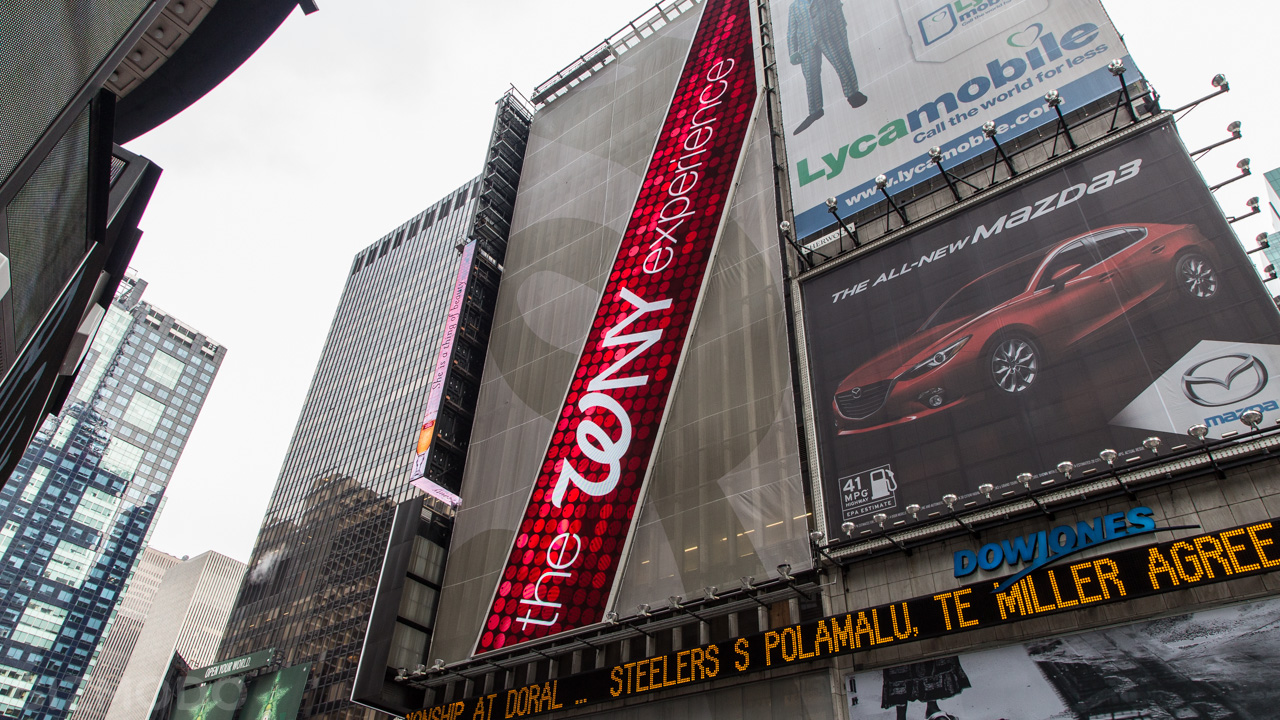
It’s hard to tell from photographs just how towering the Walgreens sign at One Times Square is, but it is. The diagonal slash is 30-stories tall, in fact.
Like Lego for Lights
At this point, you’re probably wondering exactly how these LED creations work. The answer is actually very simple. Each large LED display is actually an array of smaller LED displays that are connected to each other both physically and virtually.
The Walgreens sign is D3’s largest installation, with 29 separate displays that are lit with 16 miles of electrical cables and held together with half a million nuts and bolts. But the images themselves start out as regular old Adobe After Effects files that are then rendered into video. Clients need to supply D3 with just a single video file to get their dynamic ads in front of the 100-million-odd pedestrians who pass through the square annually. Well, that and a ton of money. An NYU study last year found that it costs a stunning $US368,291,070 a year in water, electricity and green house gas emissions to run Times Square.
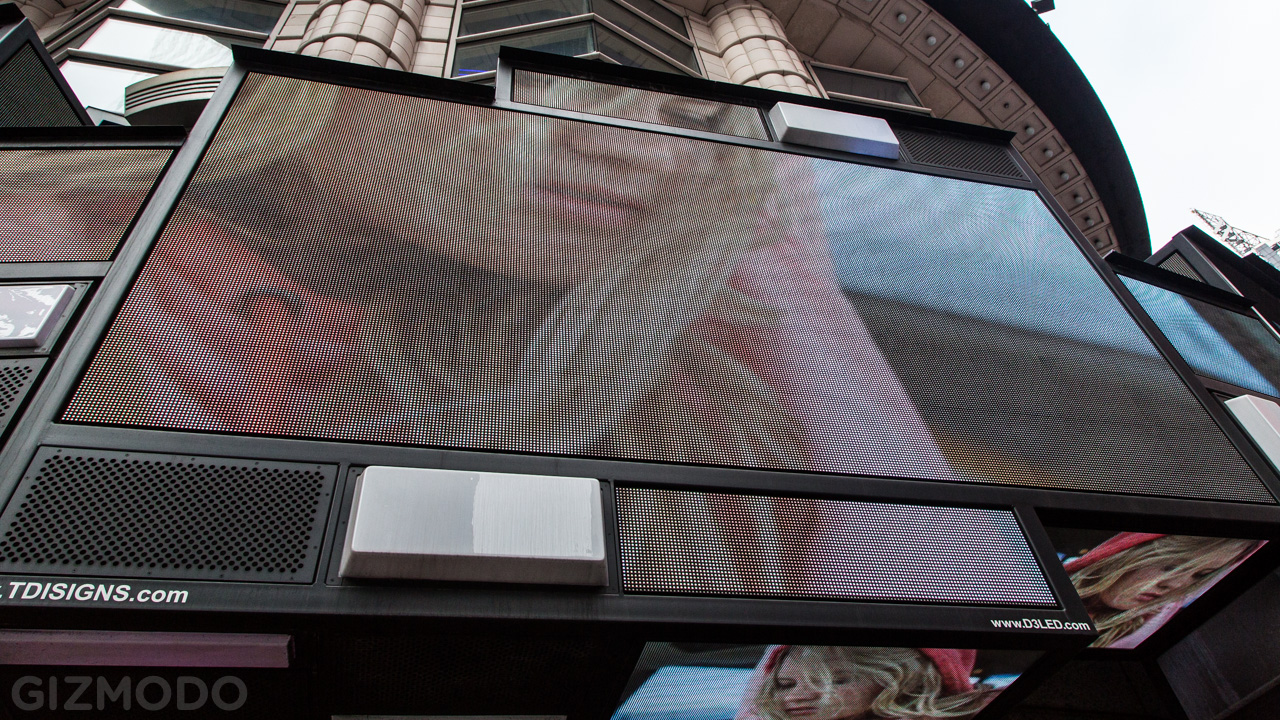
D3’s modular sign at the Quicksilver store in Times Square is one of the more creative uses of the LED module technology, with multiple displays forming a mosaic of moving images.
While the Walgreens sign looks impossibly vivid compared to its neighbours, it will fade over time, just like its painted and vinyl ancestors. LED technology is certainly much better than it used to be, but it’s still not invincible. An individual LED works by sending electricity through a semiconductor, or diode, but over time, heat causes the wires to degrade and the light to fade. The signs in Times Square, Meric told me — which stay on 24 hours a day, seven days a week — typically have a lifespan of about 10 years.
As the D3 technician told me, the LED displays are effectively giant computers. In fact, each of the individual modules is equipped with its own processor that coordinates with the rest of the modules to create one huge seamless image. The whole thing is internet-connected, too, so it can be controlled remotely. Meric told me that he gets push notifications on his phone if a sign has a problem, and no matter where he is in the world, he can troubleshoot on the fly.
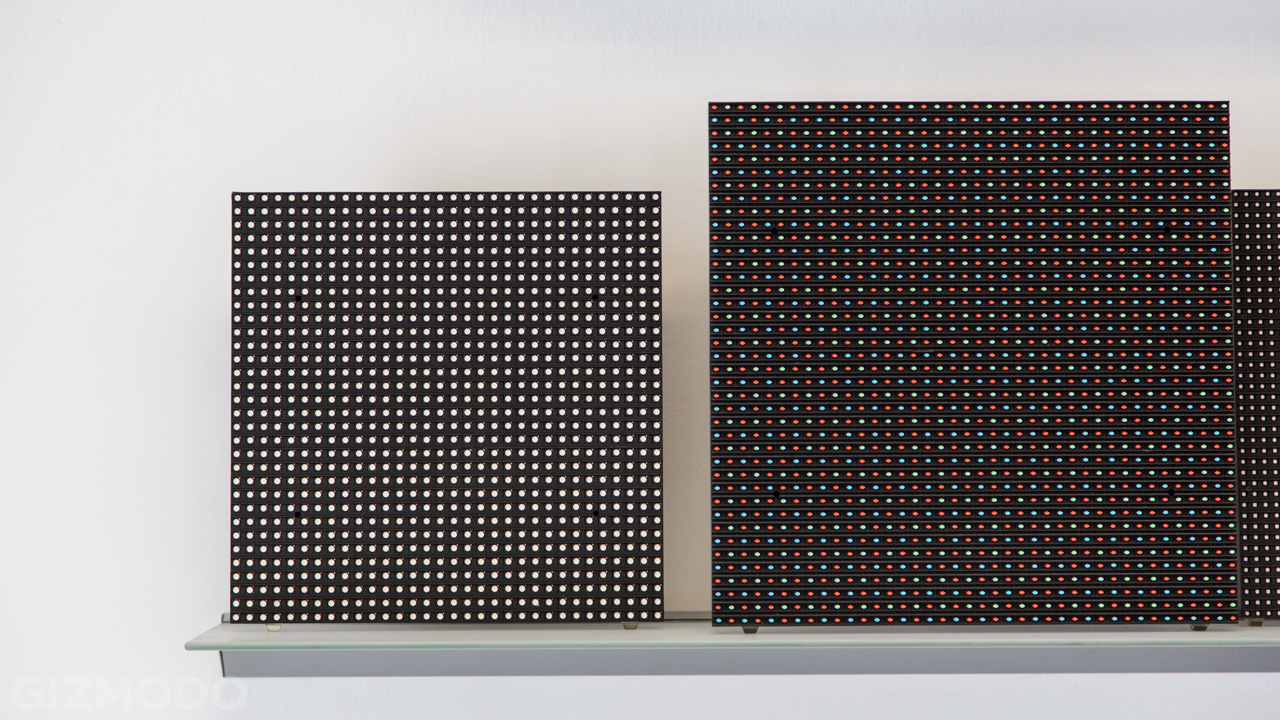
The LED modules come in several different sizes and resolutions. The pixels on modules for outdoor signs are spaced between 10 and 24 millimeters apart, while they’re usually six millimeters apart on indoor displays.
The modules also each have their own MAC address, which makes it easy for technicians to identify exactly where the problems are. This is a big improvement over the old incandescent signs that required daily checks to see if any bulbs had burnt out. While Times Square was certainly impressive back when it was coated in incandescent light, the introduction of LED technology not only transformed the types of content that could be displayed, it made maintenance so easier which encouraged more people to build the futuristic-looking displays. Dynamic billboards used to be a thing of science fiction. Now it’s the de facto standard, thanks to LEDs.
Of course, no technology is perfect. Errors don’t happen often, but when they do, fixing them is sort of a cinch. As if they were big electronic Lego bricks, the broken modules can simply be swapped out for functional ones, and they’re good to go.
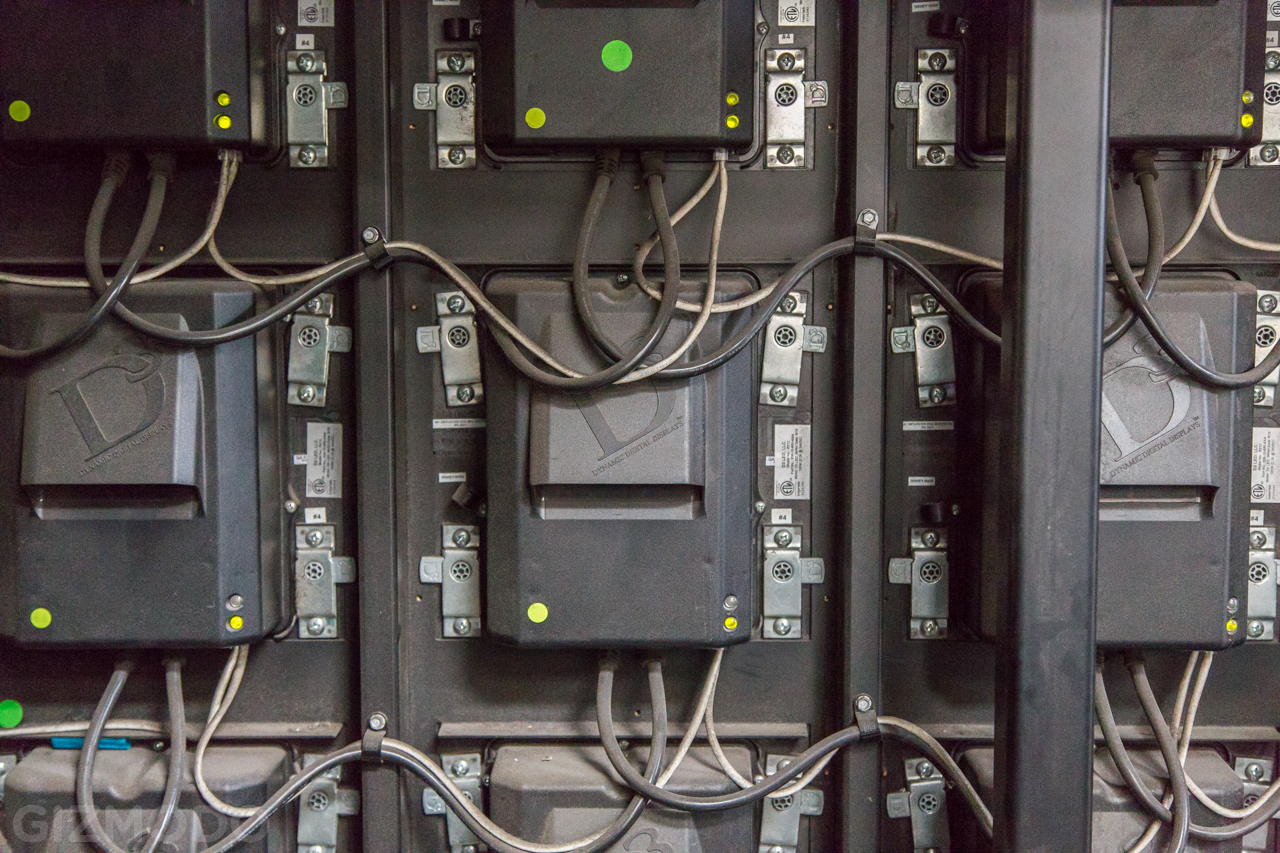
The modules (pictured from behind here) are completely, well, modular and can be swapped out in a matter of seconds.
The software that runs the whole system is also smart enough to route around problems whenever possible so that the whole sign doesn’t go down like a string of Christmas lights with a bad bulb. Meanwhile, the video files are all stored on hard drives in control rooms around Times Square, and D3 keeps backups on hand. While each sign has its own controller and control system, many of them have dedicated real estate where the hardware can live. In total, D3 operates 35 separate control rooms in Times Square.
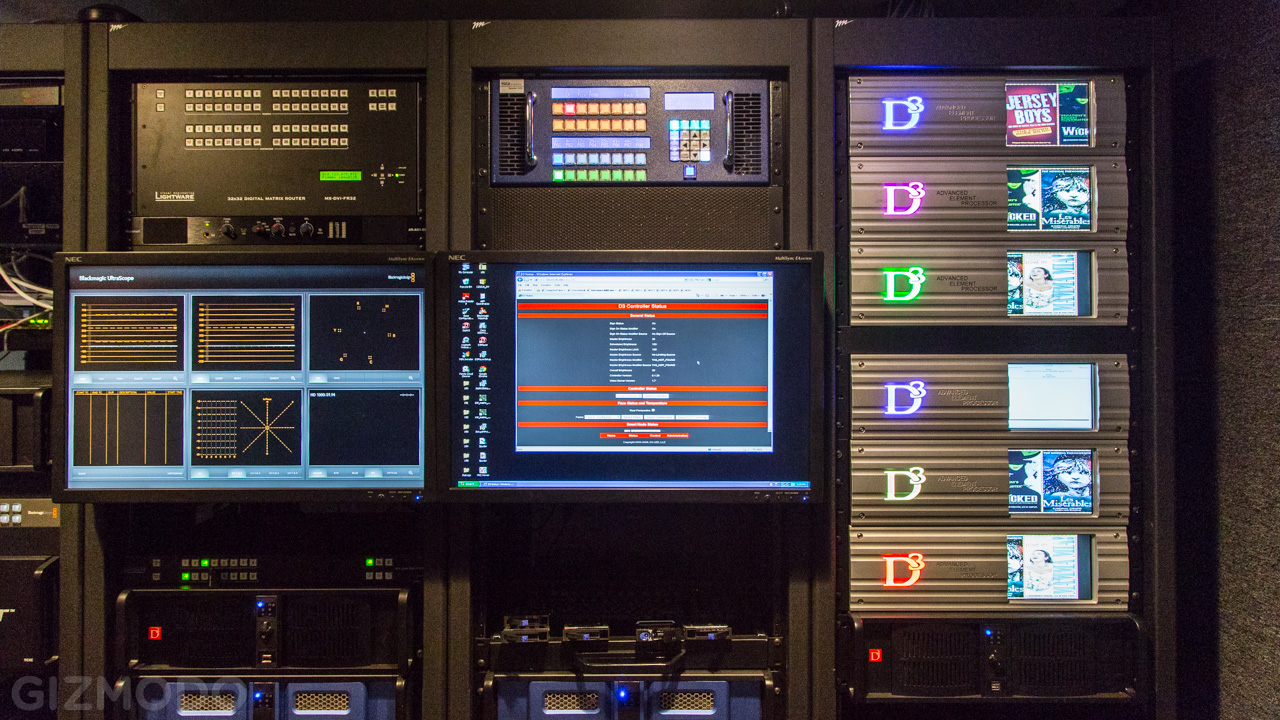
All of the control panels and server towers are custom built for D3. On the right, above, you can see the hard drives displaying previews of the live content.
Obviously, security is an issue when you’re running several dozen giant, internet-connected displays in one of the most conspicuous places on Earth. “It’s a sobering thought that you’re always vulnerable,” Meric said. “If there’s anything that keeps me up at night, it’s the security aspect.”
As such, D3 follows very rigorous protocol to ensure that the whole system doesn’t get hacked. That includes routing signals through VPNs and running intrusion detection systems at all times. And if someone wanted to physically break into one of the control rooms, they’d have a damned hard time finding them. When I visited, we walked through the bowels of some pretty nondescript buildings, ducking under pipes and climbing over ventilation ducts to find a tiny unmarked door with a bunch of servers inside. It felt like a game of hide-and-seek.
The Spectacle of Darkness
It’s not until you gaze at the backside of the largest LED display in Times Square that you can finally get a sense of perspective. First of all, these things are huge. That particular sign spans over 100 feet and weighs a whopping 82,000 pounds. It’s filled with five million LEDs that produce a resolution thats four times denser than standard definition.
While LED signs are a relatively new addition to Times Square, they’re becoming more and more popular. They’re also getting better. While the resolution of existing signs is good, the technology is starting to get great. Some of the latest D3 creations almost look like high definition displays from afar, despite the fact that the individual pixels are spaced a few millimeters apart.

An up-close look at the modules reveals how much black space is between each pixel, but you can’t even tell when looking at the displays from the ground.
As smart companies tend to do, D3 is constantly looking ahead and trying to predict the next big innovation. Believe it or not, they think it’s 3D displays. The technology isn’t quite there to support glasses-free 3D images that passers by would enjoy, but Meric and friends built the this particular LED sign with 3D in mind, though they don’t currently display any 3D content. This basically means that they have built in enough resolution and back end support that 3D could be possible with the right content. It’s outfitted with 16 state-of-the-art SSD hard drives and enough processing power to handle 5 gigabytes per second of data. (3D video requires a lot of data.) The sign is also capable of playing video at 120 frames per second, so it looks smooth as can be. Oh, and it can handle live video, too.
All of this inevitably requires a lot of electricity. New York’s main utility company, ConEd, estimates that it takes at least 161 Megawatts at any given time to keep Times Square and the surrounding theatre district glowing. A large chunk of that power goes to the signs themselves. That’s enough juice to light 161,000 American homes, and twice the amount of electricity required to power all of the casinos in Las Vegas.
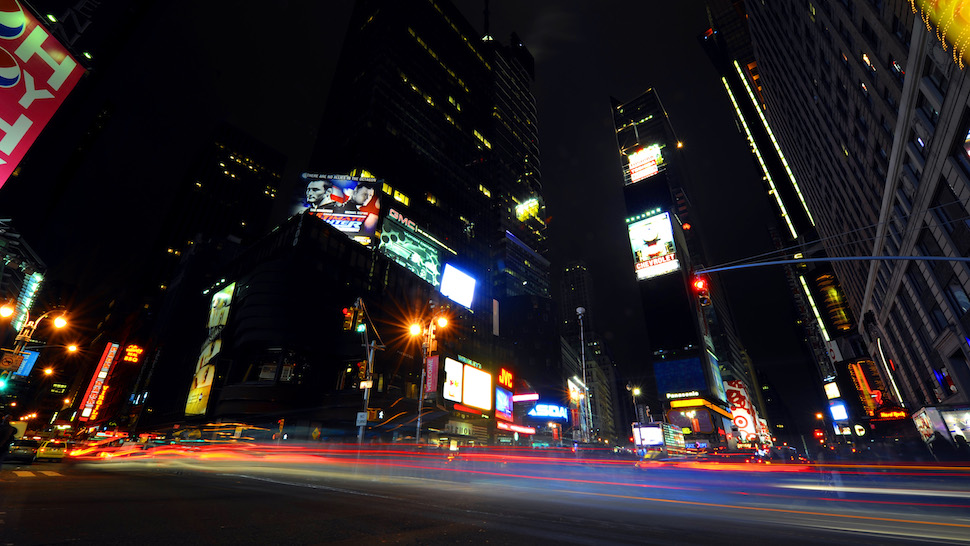
While the Earth Hour event makes the majority of the signs in Times Square go dark, there’s always a light on somewhere in New York City.
You almost never see Times Square go dark, and when it does, it’s quite a spectacle. It’s also a great way to make a statement about our bad energy habits. Earlier this year, (most of) the square went dark from 8:30pm to 9:30pm in observance of Earth Hour, organised by the World Wildlife Fund to raise awareness about energy use and conservation. One Times Square has participated in the protest (of sorts) for five years now, and Jamestown, the company that manages the building, has vowed to reduce its carbon footprint by 20 per cent before 2020. Others have made similar efforts, and one of the signs in Times Square is even powered completely by solar panels.
The Crossroads of the World
Times Square is obviously a busy place, and again, it’s an impossibly complex piece of technology in its own right. But before bright lights and the stores and the stupid naked cowboy, it was a gathering spot, not just for Americans but for people from all over the world. That’s why people call it the Crossroads of the World.
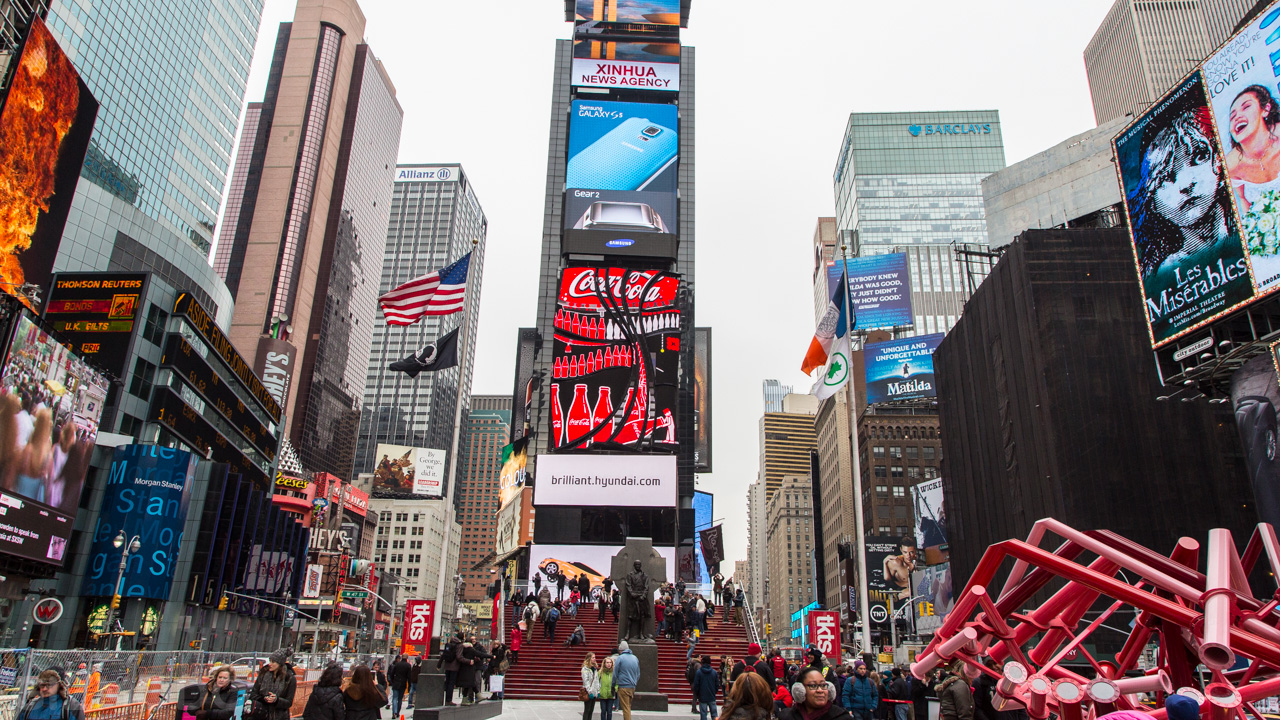
Some call this bombastic little spot, America’s Town Square. There’s even stadium seating.
While the signs don’t tell the whole story, they exist as living proof that Times Square is evolving machine, always on and always adapting to whatever the future brings. Companies like D3 make up a multimillion dollar industry that revolves simply around these ever-changing displays, a business so curiously impactful that some tourists come to New York City just to see the signs.
Perhaps most profoundly, however, is the fact that the signs stand as tribute to the unabashed glory that is American ingenuity. A hundred years ago, Times Square was just a little piece of real estate halfway into the relative countryside that was Uptown back then. A visionary newspaper owner, careful urban planning, even more careful urban renewal efforts, millions of visitors, and of course, some pretty awesome signs have now helped Times Square become one of the most iconic places on Earth.
And if you really think about it, without all those signs, Times Square would be just another messy Manhattan intersection.
Top image by Jim Cooke, photo via stockelements /
Pictures: Shutterstock.com, Michael Hession, Wikipedia, AP
